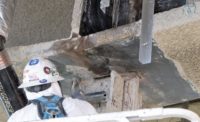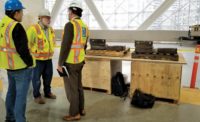Investigators for San Francisco’s Transbay Joint Powers Authority are searching for the cause of brittle fractures in the tapered bottom flanges of twin 80-ft-long built-up plate girders in San Francisco’s Salesforce Transit Center. With shoring in place to relieve the loads on the problem girders, which span Fremont Street, shoring contractors are turning their attention to similar parallel girders that span nearby First Street, though no cracks have surfaced there.
“Because Fremont and First streets are similarly designed, to be prudent, we have decided to [shore and] reinforce First Street as a proactive measure,” said Mark Zabaneh, executive director of the TJPA, in a statement released Oct. 5.
The 4.5-block-long transit hub, which TJPA opened in August and closed in late September, spans the two city streets (ENR 10/8 p. 6). TJPA said Fremont would reopen Oct. 12, after Heedy Drayage Co., Bigge Crane and Rigging Co. and Herrick Corp., which fabricated the girders, installed shoring towers from the underside of the girders’ bottom flanges down to the foundation. First Street is only closed overnight for shoring work.
TJPA has a team scrutinizing design, fabrication, materials, welds and more. Peer-reviewed repair details will be available by about Oct. 19. The hub will remain closed until the fix is complete.
Before the problems surfaced on Sept. 25, the 1.2-million-sq-ft transit center was functioning as a bus depot, with three levels above grade and a 5.4-acre rooftop park. The third-floor Fremont and First girders, which span east to west, support a rooftop park directly above and a second-floor bus deck directly below—via a hanger at the midspan.
The transit center was designed by Pelli Clarke Pelli Architects with structural engineer Thornton Tomasetti, which is involved with the investigation and the repair. The hub was built by the Webcor/Obayashi Joint Venture. Skanska USA Civil West had the $189.1-million subcontract to furnish and erect structural steel. Shop drawings were detailed by Candraft Detailing Inc., a sub of Skanska.
Bottom-flange cracks are near the 8-ft-deep midspan of each shop-welded girder. The more serious fracture is 4 in. deep and runs 2.5 ft through the entire 2.5-ft-wide flange, made of 4-in.-thick plate.
The hanger plate slots through the bottom flange with tabs welded the full depth of the girder’s web. “Cracks are only in the flange and do not touch the hanger or welded tab,” says Dennis Turchon, TJPA’s senior construction manager.
Under the flange, the hanger stub is bolted to a wide flange vertical member, in tension. The WF hangs the second floor.
TJPA has not released any shop drawings. All others parties involved, including the peer reviewer led by Degenkolb Engineers, declined to comment.
However, TJPA is releasing an electronic repository of reviews, design reports, contracts, inspections, etc., about the project. It is available on tjpa.org.
In one posted document, Degenkolb’s Loring A. Wyllie, who chaired the structural peer review panel, wrote to the city’s Dept. of Building Inspection on April 15, 2014, that the committee “finds that the current drawings for the above-grade structural package are in general conformance with the San Francisco Building Code.” The panel then recommended the city issue a building permit.









Post a comment to this article
Report Abusive Comment